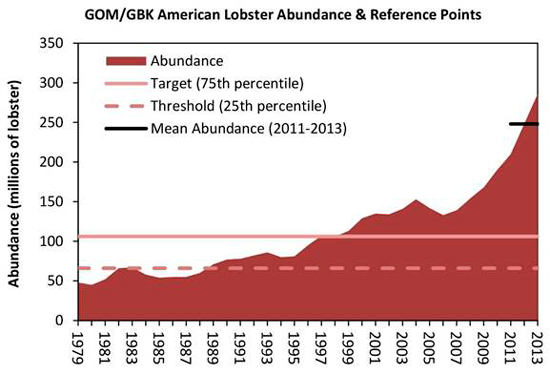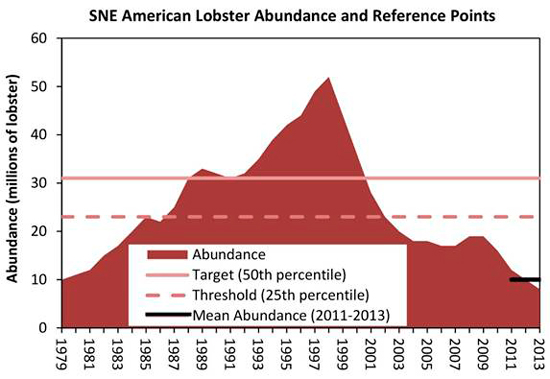American Lobster Assessment Yields Mixed Stock Status Results
Alexandria, VA, August 5, 2015 – The 2015 American Lobster Benchmark Stock Assessment and Peer Review Report indicates the American lobster resource presents a mixed picture of stock status, with record high stock abundance and recruitment in the Gulf of Maine (GOM) and Georges Bank (GBK), and record low abundance and recruitment in Southern New England (SNE). The GOM/GBK stock is not overfished and not experiencing overfishing. GOM and GBK were previously assessed as separate stock units and are now combined into one stock unit due to evidence of seasonal migratory patterns and connectivity between the two areas. Conversely, the SNE stock is severely depleted with poor prospects of recovery, necessitating protection.
Stock Status
Gulf of Maine/Georges Bank
GOM/GBK stock abundance has increased since 1979 and at an accelerated pace since 2007. Recruitment and spawning stock abundance have remained high between 2008 and 2013. Current stock abundance is at all-time highs. Exploitation (fishing mortality) declined after 1979 until the mid-1990s and then remained stable with higher exploitation on males than females. Current exploitation rates remain on par with the 2008-2013 average.
Southern New England
SNE stock abundance increased from the early 1980s, peaked during the late 1990s, then declined steeply through the early 2000s to a record low in 2013. Both the assessment and peer review support the finding that the SNE stock is severely depleted. Declines in population abundance are most pronounced in the inshore portion of the stock where environmental conditions have remained unfavorable to lobsters since the late 1990s. The stock has collapsed and is undergoing recruitment failure. Despite attrition among the fleet and fewer traps fished for lobster, declines have continued. These declines are largely in response to adverse environmental conditions including increasing water temperatures over the last 15 years combined with sustained fishing mortality.
Declines in catch and fishery-independent survey indices in the offshore portion are evident as well; however they are not as severe. It is believed the offshore area of SNE depends on nearshore larval settlement and offshore migration as the source of recruits (e.g., young of the year lobsters). Therefore, unless fishing effort is curtailed, the offshore component will be in jeopardy in the future when the poor year classes fail to materialize offshore. The Peer Review Panel noted while the SNE stock is not experiencing overfishing based on the current reference points, these reference points were established “without considering the possibility that the stock could be at the lowest abundance level ever and the production of recruits in the inshore area (on which the offshore area depends) could be brought to an extremely low level. It is noted that pre-recruits are not measured in the offshore surveys, so the effects of recruitment failure in the inshore would not be seen in the offshore until years later when the lobsters become available to the fishery and surveys. Hence, by any reasonable standard, it is necessary to protect the offshore component of the stock until increased recruitment can be observed.”
Peer Review Panel Recommendations
For SNE, the Panel recommends close monitoring of stock status along with implementing measures to protect the remaining lobster resource in order to promote stock rebuilding. Stock indicators should be updated annually and reported to the Management Board for appropriate action. Given the good condition of the GOM/GBK stock, the Panel recommended stock indicators be monitored prior to the next benchmark assessment to detect signs of changing recruitment or other conditions.
Landings
Total U.S. landings in the fishery have steadily increased in the past 35 years. Up until the late 1970s, landings were relatively constant at about 30.87 million pounds. However by 2000, landings almost tripled to roughly 86 million pounds and by 2006 grew to 92.61 million pounds. Landings in 2013 were roughly 149.94 million pounds. These landings are primarily comprised of catch from inshore waters (0 to 12 nautical miles). GOM supports the largest fishery, constituting approximately 76% of the U.S. landings between 1981 and 2007 and accounting for approximately 87% of landings since 2002. Landings in the GOM were stable between 1981 and 1989, averaging 32.13 million pounds, and then increased dramatically from 42.34 million pounds (1990) to 141.12 million pounds (2013). Landings averaged 112.46 million pounds from 2008-2013. GBK constitutes a smaller portion of the U.S. fishery, with landings averaging 4.93 million pounds between 2008 and 2013. Like the GOM, landings were stable in the 1980s and then quickly doubled in the early 2000s to a high of 5.29 million pounds in 2005. Before 2011, SNE was the second largest fishery, accounting for 19% of the U.S. landings between 1981 and 2007; however, a sharp decline in the population has significantly reduced catch. Landings peaked in the 1990s, reaching a high of 21.91 million pounds in 1997. Since this time, landings have precipitously dropped to a low of 3.31 million pounds in 2013.
The Board accepted both the stock assessment and peer review report for management use. In response to the findings regarding the status of the SNE stock, the Board established a working group of Board and Technical Committee members to review the assessment and peer review findings and develop recommendations for Board consideration. The final report will be available by mid-August via the Commission’s website at www.asmfc.org on the American Lobster page under Stock Assessment Reports. For more information, please contact Megan Ware, Fishery Management Plan Coordinator for Management, at 703.842.0740 or mware@asmfc.org.


